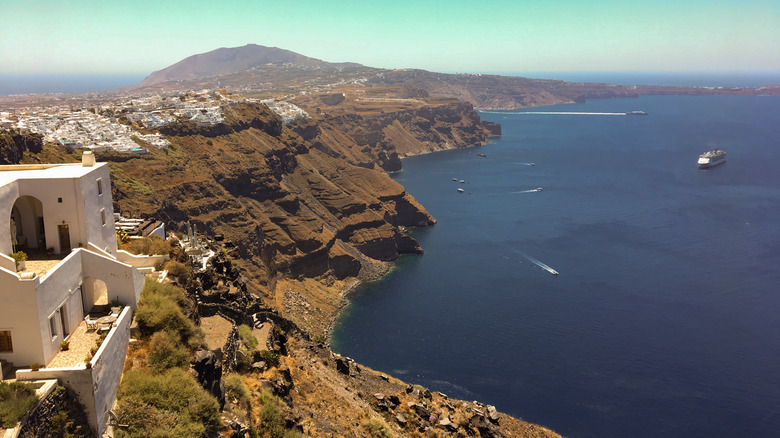Greece's Secret Hot Springs Are A Less Crowded Alternative To Iceland's Blue Lagoon
Some luxurious hot springs destinations offer outstanding views, but travelers from around the globe frequently seek out the natural baths for their therapeutic benefits. The allure of soaking in these mineral-rich waters has captivated those in search of relief and rejuvenation. While Iceland's Blue Lagoon often comes to mind as the quintessential hot spring experience, it's often considered one of the most disappointing attractions in the world, as its popularity also means larger crowds and higher costs. For those in pursuit of a more serene and affordable alternative, the hot springs of Santorini in Greece blend tranquility and natural beauty in an unforgettable experience.
Located in a secluded cove on the island of Palea Kameni, these hot springs were formed by the same volcanic activity that shaped the area itself. Unlike the artificial Blue Lagoon, Santorini's hot springs are entirely natural, heated by the magma that still bubbles beneath the island. The water in the springs can reach temperatures of up to 95 degrees Fahrenheit, making it the perfect hub for relaxation. The springs are rich in minerals that are famous for their therapeutic properties. The sulfur, iron, and manganese found in these waters provide a rejuvenating wellness experience, soothing skin afflictions, alleviating joint pain, and relaxing tired muscles.
How to prepare for Santorini's hot springs
Most visitors reach Santorini's hot springs via boat tours that depart from the main island, which often include stops at other nearby attractions, such as the volcanic craters. This makes for a full day of exploration, combining the thrill of adventure with the relaxation of soaking in mineral-rich waters. Budget-friendly travelers will be pleased to know that the prices are reasonable.
It's important to note that the hot springs are not for everyone. While beneficial for the skin, the water's high sulfur content gives it a distinct smell and can stain clothing, so it's advisable to wear old, dark-colored swimwear. Apart from bringing a change of clothes, visitors should also bring hats, sunscreen, and water shoes since the rocks surrounding the springs can be sharp and slippery. Despite these minor drawbacks, this destination remains a must-visit for anyone looking to experience the natural beauty of Santorini in a more intimate setting.
When to visit Santorini
To make the most of your visit, you'll want mild temperatures and glorious rays of sun, so it's best to go in the summer. It's important to note that other travelers will also take advantage of the warm weather. If you want to avoid crowds, head to the springs first thing in the morning or later in the afternoon for a more peaceful experience. Additionally, visiting during low tide ensures that the water is shallow enough for comfortable swimming.
In comparison to Iceland's Blue Lagoon, Santorini's hot springs offer a more affordable and less commercialized alternative. There's no need for expensive entry fees or advance bookings; it's just a simple boat ride to a natural wonder that has been quietly bubbling away for centuries. So, if you're looking for a hot springs experience that combines natural beauty, therapeutic benefits, and a touch of adventure, these hidden springs are perfect. To further escape Santorini's crowds of tourists and high prices, head to the island of Crete.


